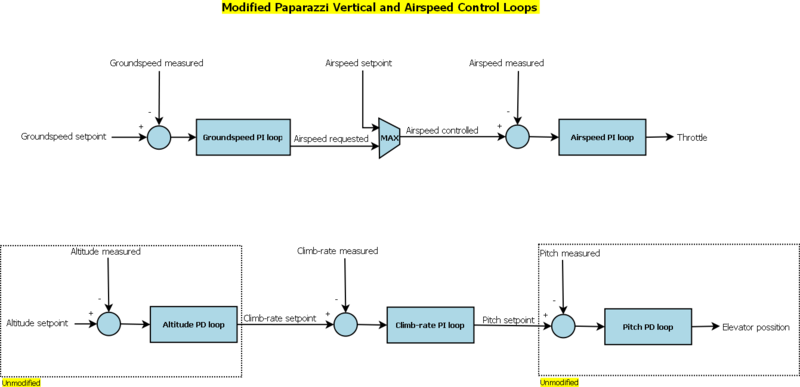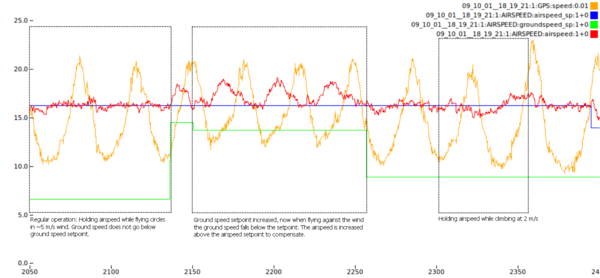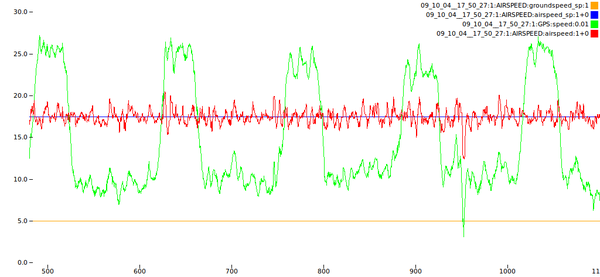Difference between revisions of "Airspeed sensor"
Markgriffin (talk | contribs) |
Markgriffin (talk | contribs) |
||
| Line 38: | Line 38: | ||
[[Image:Airspeed.png|left|800px]] | [[Image:Airspeed.png|left|800px]] | ||
<br style="clear:both"> | <br style="clear:both"> | ||
The following | The following plot is from an actual test flight after spending some time setting the loop gains (the real-time tuning through the GCS is a time saver!). The plane was flying circles at a constant altitude (except in the end). The wind was about 5 m/s, judging from the ground speed variations. In the middle there is an example of what happens when the ground speed falls below the setpoint. Finally the altitude setpoint was changed to verify that the airspeed will be maintained while climbing. | ||
[[Image:PlotAS2.png|left|600px]] | [[Image:PlotAS2.png|left|600px]] | ||
<br style="clear:both"> | <br style="clear:both"> | ||
The benefits of the airspeed hold are obvious in this example. The throttle adjusts to keep the airspeed close to the setpoint. | The benefits of the airspeed hold are obvious in this example. The throttle adjusts to keep the airspeed close to the setpoint. | ||
Revision as of 04:00, 26 July 2010
By default, airspeed is estimated by measuring the GPS ground speed. This gives reasonable results particularly in calm conditions. Airspeed sensors measure actual airspeed resulting in better performance especially in windy conditions.
Connecting the EagleTree Airspeed Sensor
The EagleTree Airspeed Sensor is a low cost module and comes with a very good pitot tube (Prandtl style, pitot-static tube) that includes static and dynamic ports. It has an I2C interface that connects directly to the Tiny/TWOG I2C port. The autopilot code has been modified to regulate the throttle in order to keep the airspeed constant (and a minimum ground speed). The airspeed sensor should be set to operate in the default RAW mode (not switched to 3rd party mode).
First, connect the sensor directly to the TWOG (J6). The sensor module wires are:
Red wire: 5V White wire: Ground Yellow wire: SDA Brown wire: SCL
Add the following to the end of the "VERTICAL CONTROL" section of the airframe file:
<define name="AUTO_AIRSPEED_SETPOINT" value="15.0" unit="m/s"/> <define name="AUTO_AIRSPEED_PGAIN" value="0.060"/> <define name="AUTO_AIRSPEED_IGAIN" value="0.050"/> <define name="AUTO_GROUNDSPEED_SETPOINT" value="6.0" unit="m/s"/> <define name="AUTO_GROUNDSPEED_PGAIN" value="0.75"/> <define name="AUTO_GROUNDSPEED_IGAIN" value="0.25"/>
Note that the SETPOINT values may need to be adjusted to suit your aircraft.
Then, in the airframe file (near the end of the file), you have to add:
ap.CFLAGS += -DUSE_AIRSPEED_ETS -DUSE_AIRSPEED -DUSE_I2C0 -DAGR_CLIMB ap.srcs += airspeed.c airspeed_ets.c i2c.c $(SRC_ARCH)/i2c_hw.c
See paparazzi3/conf/airframes/easystar2.xml for an example airframe configuration.
The airspeed can be displayed in the Messages tool by adding the AIRSPEED message to /conf/telemetry/default.xml as follows:
<process name="Ap">
<mode name="default">
<message name="AIRSPEED" period="1.0"/>
...
Please note that in the GCS, the strip displays ground speed (not airspeed). In order to display airspeed, drag-and-drop the airspeed message field from the Messages tool onto the 2D map of the GCS.
The altitude and airspeed loops are separated as shown in the diagram below. Basically the throttle and pitch are controlled independently and are not coupled in the control loops (of course one affects the other but the control loops are independent). The airspeed is controlled by two cascaded PI loops, the first is used to regulate the ground speed and the second the airspeed. This is needed to ensure that if the ground speed drops below a certain value the airspeed will be increased to compensate (in order to maintain a valid GPS heading).
The following plot is from an actual test flight after spending some time setting the loop gains (the real-time tuning through the GCS is a time saver!). The plane was flying circles at a constant altitude (except in the end). The wind was about 5 m/s, judging from the ground speed variations. In the middle there is an example of what happens when the ground speed falls below the setpoint. Finally the altitude setpoint was changed to verify that the airspeed will be maintained while climbing.
The benefits of the airspeed hold are obvious in this example. The throttle adjusts to keep the airspeed close to the setpoint.
The following aspects still need to be looked at:
* Test EagleTree sensors in 3rd party mode * Revert to GPS measurements if the sensor fails
Thanks very much to Vassilis for developing and testing the code.


